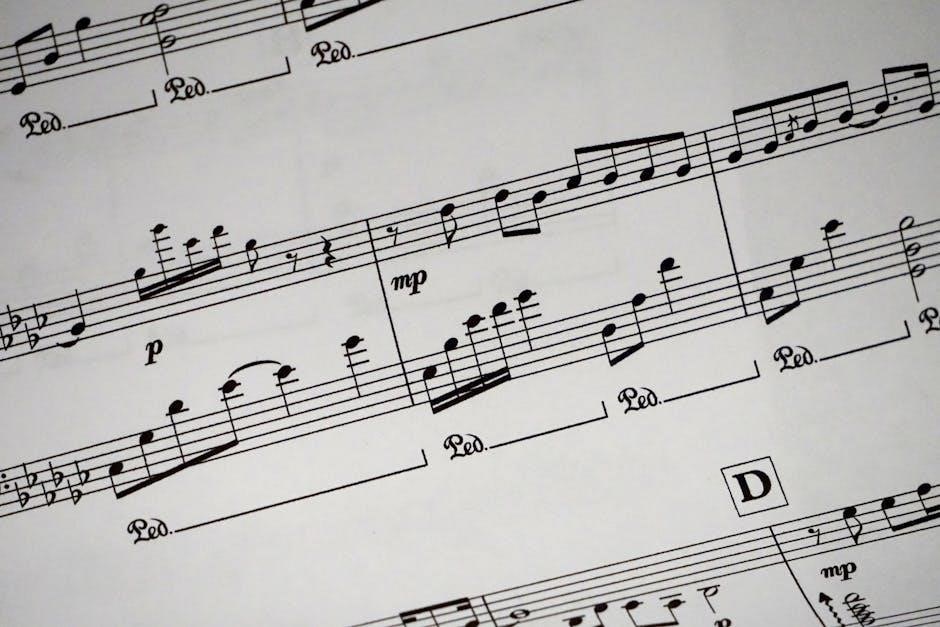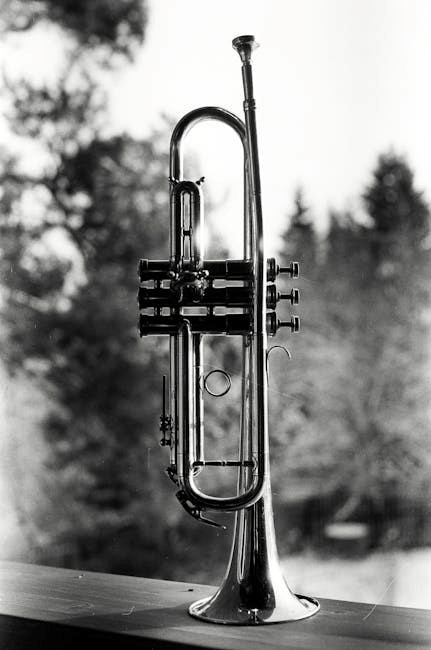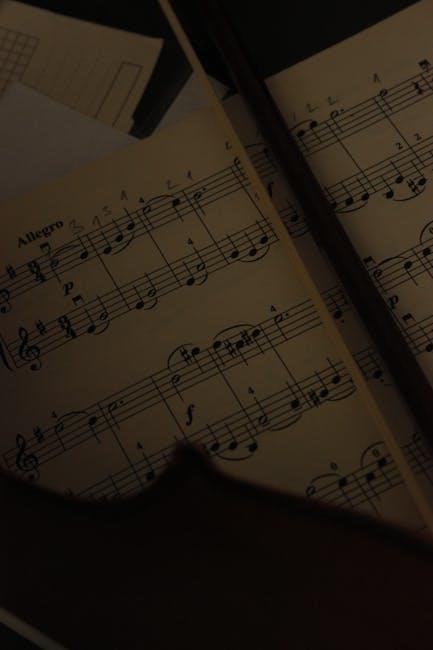The Creston Sonata for E-flat alto saxophone and piano, composed by Paul Creston in 1939, is a significant work in classical saxophone repertoire, commissioned by Cecil Leeson, featuring three movements.
1.1 Overview of the Sonata
The Creston Sonata, composed in 1939 for E-flat alto saxophone and piano, is a three-movement work commissioned by saxophonist Cecil Leeson. Completed by August 1939, it was initially slated for 1940 publication but delayed until 1945 due to WWII. Known for its rhythmic energy, lyrical melodies, and harmonic depth, the sonata has become a cornerstone of classical saxophone repertoire, showcasing Creston’s mastery of neoclassical and romantic influences.

1.2 Historical Context of the Composition
Composed in 1939 by Paul Creston, the sonata was commissioned by saxophonist Cecil Leeson, reflecting the growing popularity of the saxophone in classical music. The piece was completed by August 1939 but its publication was delayed until 1945 due to World War II. Creston, an Italian American composer, drew on neoclassical and romantic influences, creating a work that bridged tradition and innovation during a turbulent period in global history.
1.3 Importance of the Creston Sonata in Classical Music
The Creston Sonata holds a prominent place in classical music, particularly for the saxophone, due to its technical and emotional depth. It showcases Creston’s unique style, blending rhythmic complexity with harmonic richness, making it a cornerstone of saxophone repertoire. The sonata’s enduring popularity stems from its balanced structure and expressive qualities, appealing to both performers and audiences, thus solidifying its significance in classical music history.

Structure and Movements of the Sonata

The Creston Sonata is divided into three movements, each showcasing distinct tempo and emotional contrasts, from the lively first movement to the reflective second and dynamic third.
2.1 First Movement: Tempo and Characteristics
The first movement of Creston’s Sonata, marked “With vigor,” begins at a brisk tempo of 126 beats per minute. It features dynamic contrasts, rhythmic complexity, and a brief calming section before accelerating again. The movement showcases a lively, energetic dialogue between the saxophone and piano, with intricate passagework and harmonic richness, establishing the Sonata’s vibrant and assertive character from the outset.
2.2 Second Movement: Emotional Depth and Harmony
The second movement of Creston’s Sonata offers a stark contrast to the first, with a calm and reflective tempo. It features emotional depth through lush harmonies and melodic richness. The saxophone and piano engage in a serene dialogue, showcasing Creston’s ability to craft lyrical passages. A gradual retard adds dramatic tension, while the harmonic structure maintains a sense of stability, making this movement a heartfelt centerpiece of the Sonata.
2.3 Third Movement: Rhythmic Complexity and Conclusion
The third movement of Creston’s Sonata is marked by rhythmic intricacies, with a Presto tempo that demands technical precision. The saxophone showcases virtuosic leaps and articulations, while the piano provides a driving accompaniment. The movement concludes with a dramatic coda, tying together thematic elements from the Sonata. This finale highlights Creston’s mastery of rhythm and structure, leaving a lasting impression on listeners with its dynamic energy and technical brilliance.

Paul Creston: The Composer Behind the Sonata
Paul Creston, born Giuseppe Guttoveggio in 1906, was an Italian-American composer of classical music. Self-taught, his works include symphonies and concertos, reflecting a conservative style with strong rhythmic elements.
3.1 Biography of Paul Creston
Paul Creston, born Giuseppe Guttoveggio on October 10, 1906, in New York City to Sicilian immigrants, was a self-taught composer of classical music. His works, known for their conservative style and strong rhythmic elements, include six symphonies and numerous concertos. Creston’s compositions reflect his unique voice, blending traditional forms with innovative techniques. He passed away on August 24, 1985, leaving a legacy of significant contributions to classical music, including his iconic saxophone sonata.
3.2 Creston’s Musical Style and Contributions
Paul Creston’s music is characterized by a conservative style with strong rhythmic emphasis. His compositions often blend traditional forms with innovative techniques. Creston’s works include six symphonies and various concertos, reflecting his unique voice. The Creston Sonata, showcasing his rhythmic complexity, is a cornerstone of saxophone repertoire, highlighting his enduring influence on classical music.
3.3 Other Notable Works by Paul Creston
Paul Creston’s oeuvre includes six symphonies, concertos for violin and saxophone, and works for wind ensemble. His Concerto for Alto Saxophone, Op. 26, is particularly renowned, showcasing his mastery of rhythmic and harmonic elements. Creston’s compositions are celebrated for their lyrical depth and structural clarity, leaving a lasting impact on classical music.
Availability and Access to the Creston Sonata PDF
The Creston Sonata PDF is widely available online through platforms like Google Drive, Musicnotes, and free sheet music websites, offering both free and paid access options.
4.1 Reliable Sources for Downloading the PDF
Reputable sources for downloading the Creston Sonata PDF include Sheet Music Direct, Musicnotes, and Google Drive. These platforms offer high-quality, legally available scores, ensuring authenticity and clarity. Additionally, free sheet music platforms, while sometimes less reliable, provide accessible versions for study purposes. Always verify the source’s credibility to ensure you obtain an accurate and complete copy of the sonata.
4.2 Free Sheet Music Platforms Offering the Sonata
Several free sheet music platforms offer the Creston Sonata PDF, including MuseScore and IMSLP. These websites provide accessible versions of the sonata, enabling musicians and students to explore the piece without cost. While quality may vary, these platforms are popular for educational and practice purposes. Users are advised to verify the credibility of the source to ensure accuracy and completeness of the score.
4.3 Purchase Options for the Official Score
The official score of the Creston Sonata can be purchased through reputable music retailers like Sheet Music Direct and G. Schirmer. These platforms offer high-quality PDF and MIDI versions, ensuring accuracy and authenticity. Additionally, some publishers provide arranged versions for different instruments, catering to diverse musical needs. Purchasing the official score supports the legacy of Paul Creston and guarantees a professional-grade performance material.

Analysis and Interpretation of the Sonata
The Creston Sonata is celebrated for its rhythmic vitality and harmonic richness, showcasing Creston’s unique neoclassical style. Its structured movements and emotional depth offer profound interpretative possibilities for musicians.
5.1 Musical Themes and Motifs
The Creston Sonata features distinct musical themes that blend lyrical melodies with rhythmic intensity. The first movement introduces a bold motif with ascending arpeggios, while the second movement explores more reflective and emotional themes. The third movement incorporates intricate syncopation and motivic development, creating a cohesive narrative throughout the sonata. These themes are executed with precision, showcasing Creston’s mastery of thematic development and musical storytelling.
5.2 Rhythmic and Harmonic Innovations
Paul Creston’s sonata showcases innovative rhythmic and harmonic techniques, blending traditional forms with modern elements. The first movement features bold syncopation and polyrhythms, while the second movement employs calming, legato passages. The third movement highlights Creston’s mastery of rhythmic complexity, with intricate time shifts and harmonic explorations. His use of tonal harmony, combined with occasional atonal flourishes, creates a distinctive and forward-thinking sound, reflecting his Italian heritage and modern influences.
5.3 Critical Reception and Academic Analysis
The Creston Sonata has garnered widespread critical acclaim for its structural integrity and emotional depth. Scholars, such as A.M. Понькина and R.B. Eckers, have analyzed its rhythmic complexity and harmonic innovation. Eckers’ dissertation highlights the sonata’s balance of traditional forms with modern elements. It is widely regarded as a cornerstone of saxophone literature, with its technical and artistic challenges making it a subject of scholarly study and performance excellence in classical music circles.

Performance Considerations
The Creston Sonata demands precise technical skill and interpretive insight, blending rhythmic complexity with emotional depth, requiring strong collaboration between saxophonist and pianist for a compelling performance.
6.1 Technical Challenges for Saxophonists
The Creston Sonata presents significant technical demands, including intricate finger dexterity, precise articulation, and mastery of the altissimo register. Saxophonists must navigate complex rhythms, rapid passagework, and dynamic contrasts while maintaining tonal clarity and control. The piece also requires strong breath control and embouchure stamina to handle its virtuosic demands. Musicians must carefully balance technical precision with expressive interpretation to convey the sonata’s emotional depth and structural complexity effectively.
6.2 Collaborative Aspects with the Pianist
The Creston Sonata demands a strong collaborative relationship between the saxophonist and pianist. Both parts are intricately woven, requiring precise timing and dynamic balance. The pianist must navigate complex harmonic passages while supporting the saxophone’s melodic lines. Clear communication and shared musical intent are essential to achieve the sonata’s dramatic contrasts and lyrical moments. Rehearsal and mutual understanding are crucial to ensure a cohesive and expressive performance of this challenging yet rewarding work.
6.3 Tips for Interpreting the Sonata
Interpreting the Creston Sonata requires balancing technical precision with emotional depth. Saxophonists should emphasize dynamic contrasts and phrasing to convey the work’s dramatic intensity. Attention to rhythmic accuracy is crucial, especially in the third movement’s complex passages. Pianists must provide a supportive yet expressive accompaniment, ensuring harmonic clarity. Detailed study of the score and collaborative rehearsals are essential to capture Creston’s unique voice and deliver a compelling performance that honors the sonata’s artistic intent.

The Sonata’s Place in Saxophone Repertoire
The Creston Sonata is a cornerstone of saxophone literature, showcasing the instrument’s technical and expressive potential. Its intricate composition has solidified its essential place in classical saxophone repertoire, making it a fundamental work for both students and professionals to master and perform.
7.1 Influence on Modern Saxophone Music
The Creston Sonata has profoundly influenced modern saxophone music through its innovative structure and harmonic depth. Composed in 1939, it set a new standard for technical and expressive demands, inspiring later composers to explore similar rhythmic and harmonic complexities. Its enduring popularity and technical challenges make it a benchmark for saxophonists, shaping the evolution of classical saxophone repertoire and remaining a cornerstone of modern performances.
7.2 Comparison with Other Saxophone Sonatas
The Creston Sonata stands out among other saxophone sonatas for its unique blend of rhythmic vitality and harmonic richness. While works like Glazunov’s Concerto and Milhaud’s Scaramouche emphasize lyrical and virtuosic elements, Creston’s Sonata balances technical demands with emotional depth, offering a distinct voice in the saxophone repertoire. Its structured complexity and expressive range set it apart, making it a cornerstone of classical saxophone literature.
7.3 Educational Value for Students
The Creston Sonata is a cornerstone of saxophone education, offering students a rich exploration of technical and expressive challenges. Its balanced structure, rhythmic complexity, and harmonic depth provide invaluable learning opportunities. Students develop phrasing, dynamics, and articulation skills while engaging with a quintessential work of the saxophone repertoire. The sonata’s historical significance and artistic depth make it a foundational piece for advancing musicians, often featured in college and conservatory curricula.

Cultural and Artistic Impact
The Creston Sonata is a landmark in classical saxophone literature, blending rhythmic vitality with lyrical expression, leaving a lasting impact on music history and audience appreciation worldwide.
8.1 The Sonata’s Role in Classical Music History
The Creston Sonata is a cornerstone of classical saxophone repertoire, composed in 1939 for Cecil Leeson. It stands as one of the first sonatas written for the Alto Saxophone, blending rhythmic complexity with lyrical passages. Despite its 1945 publication delay due to WWII, the work remains a landmark, influencing modern saxophone music and solidifying Creston’s legacy in classical composition.
8.2 Audience Reception and Popularity
The Creston Sonata has garnered widespread acclaim for its emotional depth and technical brilliance, making it a favorite among saxophonists and classical music enthusiasts. Its balanced blend of rhythmic complexity and melodic beauty resonates with audiences, while its challenging nature attracts advanced performers. The sonata’s popularity endures, with frequent performances and educational use, solidifying its place as a cornerstone of saxophone repertoire and a testament to Creston’s enduring legacy in classical music.
8.3 Legacy of the Creston Sonata
The Creston Sonata remains a cornerstone of classical saxophone repertoire, influencing generations of composers and performers. Its innovative use of rhythm and harmony has set a benchmark for saxophone music. The sonata’s enduring popularity in educational and performance settings underscores its lasting impact, ensuring its continued relevance and appreciation in the classical music world, while inspiring future musicians to explore its rich musical landscape and technical challenges.

Sheet Music Arrangements and Editions
The Creston Sonata is available in various arrangements, including transcriptions for different instruments and piano reductions, offering flexibility for performers and educators to explore its rich musicality.
9.1 Available Arrangements for Different Instruments
The Creston Sonata is widely arranged for various instruments, ensuring its accessibility. Versions for piano, guitar, and flute are popular, maintaining the original’s musical integrity. Sheet Music Direct and Musicnotes offer these arrangements, allowing performers to explore the sonata beyond its traditional saxophone and piano setup, making it a versatile piece for diverse instrumentalists.
9.2 Transcriptions and Adaptations
The Creston Sonata has been transcribed for solo instruments and orchestral settings, preserving its harmonic richness. Arrangements for flute, guitar, and violin maintain the original’s emotional depth. These adaptations highlight the sonata’s versatility, allowing it to resonate across diverse musical ensembles while staying true to Creston’s compositional intent and style.
9.4 Editorial Variations in Published Scores
Different editions of the Creston Sonata PDF reveal editorial variations, such as subtle changes in tempo markings, dynamic indications, and articulations. Some publishers include additional annotations or performance notes, while others present the score in its original form. These variations can influence interpretation, making it essential for musicians to compare editions. Such differences highlight the evolving nature of the sonata’s publication history and its adaptation to modern performance practices.
The Creston Sonata remains a cornerstone of classical saxophone repertoire, offering rich musical themes and technical challenges. Its enduring appeal invites continuous exploration and appreciation by musicians and audiences alike.
10.1 Final Thoughts on the Creston Sonata PDF
The Creston Sonata PDF is an invaluable resource for saxophonists and pianists, offering a detailed and accessible version of this iconic work. Its digital format ensures preservation and ease of access, making it a cornerstone for both study and performance. The PDF captures the essence of Creston’s compositional genius, providing a timeless musical experience that continues to inspire artists and audiences globally. It remains a quintessential piece in classical saxophone literature.
10.2 Encouragement for Further Exploration
Exploring the Creston Sonata PDF offers a gateway to Paul Creston’s musical brilliance and his significant contribution to classical saxophone repertoire. Musicians and enthusiasts are encouraged to delve into the score, analyzing its intricate harmonies and rhythmic nuances. The PDF’s accessibility makes it an ideal resource for both performance and study, providing insight into Creston’s compositional style. Embrace this opportunity to connect with a masterpiece that continues to inspire and influence modern saxophone music, ensuring its legacy endures.
10.3 The Enduring Appeal of the Sonata
The Creston Sonata remains a cornerstone of saxophone repertoire due to its emotional depth, rhythmic complexity, and harmonic richness. Its enduring appeal lies in its ability to connect with both performers and audiences, offering a balance of technical challenge and expressive beauty. As a seminal work, it continues to inspire new generations of musicians, solidifying its place in classical music history and ensuring its relevance for years to come.